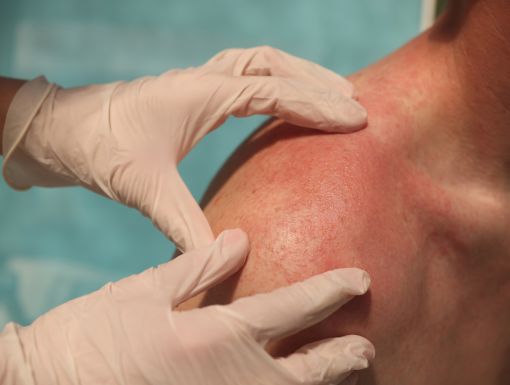
What Are the 3 Main Types of Skin Cancer?
Skin cancer is the most common of all cancers and occurs when normal cells grow and multiply without control. As cells multiply, they form a mass called a tumor. Tumors overtake surrounding tissues by invading their space and depriving those areas of the body of the nutrients they need to survive. Skin cancer can develop differently and look differently based on its type. There are three main types of skin cancer: basal cell carcinoma, squamous cell carcinoma and melanoma. Knowing the characteristics of each can help you detect skin cancer in its earliest stages.
Basal Cell Carcinoma
Basal cell carcinoma is the most common type of skin cancer and usually develops in people who have fair skin, but people of color can also get this type of skin cancer. It looks like a skin tone colored, round growth or bump or it may look like a pink patch of skin. Basal cell carcinoma typically develops because of years of sun exposure or indoor tanning. In terms of diagnosis, early detection and treatment for basal cell carcinoma are especially important as basal cell carcinoma can grow deep into the body and can affect your nerves and bones.
Squamous Cell Carcinoma
Squamous cell carcinoma is the second most common type of skin cancer and can present itself as a red firm bump, a scaly patch or a sore that heals and reopens. Squamous cell carcinoma tends to develop on areas of the body that get frequent sun exposure like the ears, face, neck and arms. Early diagnosis of squamous cell carcinoma can prevent it from spreading to other areas of the body.
Squamous cell carcinoma can also develop from precancerous skin growth. Some people may develop dry spots on their skin known as actinic keratoses.
Melanoma
Melanoma is the most well-known and often the deadliest form of skin cancer. Melanoma usually develops from a mole or appears as a new, dark spot on the skin. As with the other forms of skin cancer early detection is key when dealing with melanoma.
When determining if a mole or pigmented spot is potentially dangerous, look for the ABCDEs of melanoma:
- A – Asymmetry
One side of the mole or spot is different than the other
- B – Border
The border of the spot has an irregular, jagged or poorly defined border - C – Color
The color of the spot varies from one area to the next, with shades ranging from tan, brown, black, white, red or blue
- D – Diameter
Melanomas are usually larger than 6 millimeters, about the size of a pencil eraser, but can be smaller
- E – Evolving
Evolving means that the size, shape and color of the spot change over time.
Learn more about Cancer Services at Ochsner Health.



